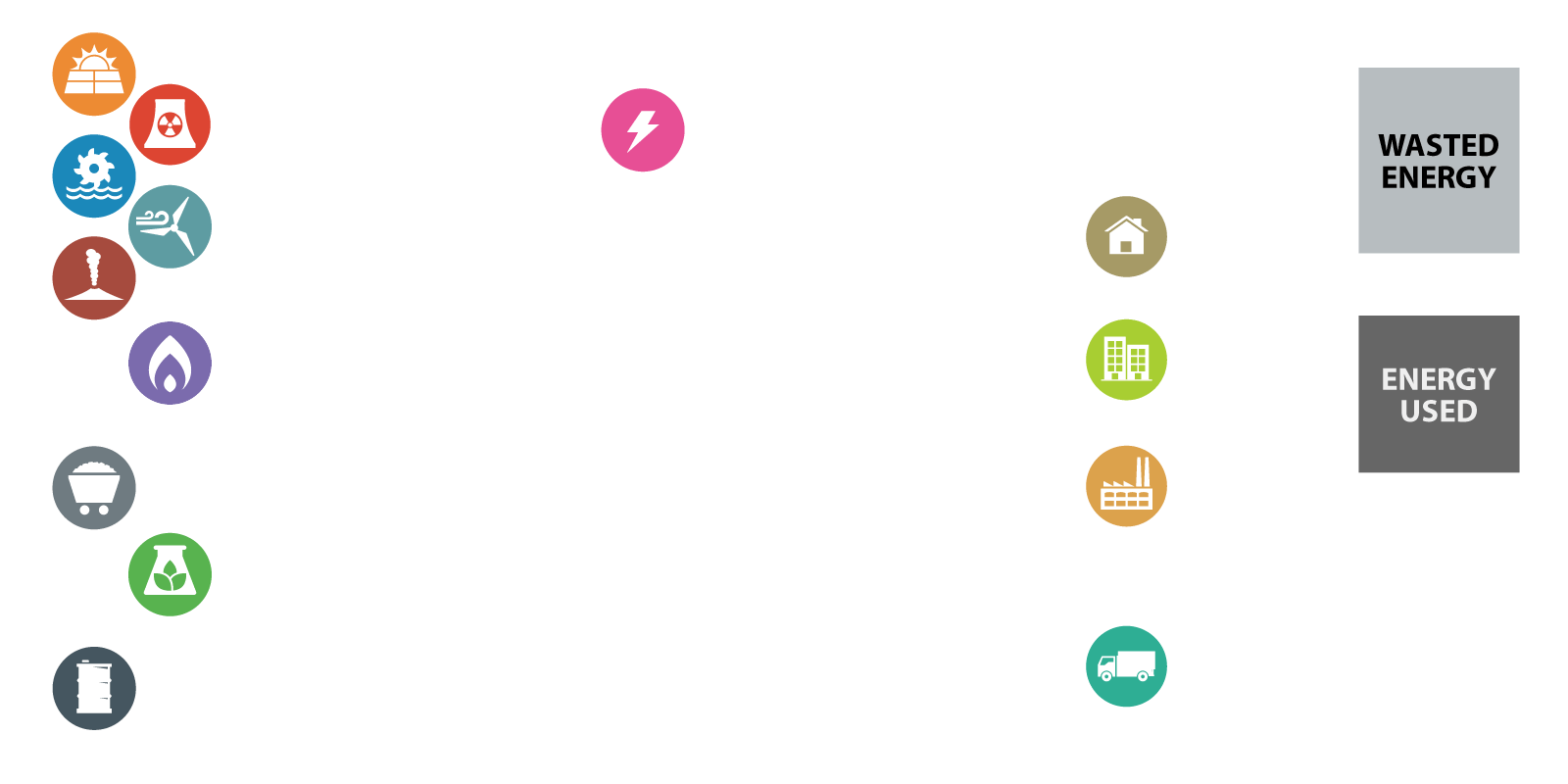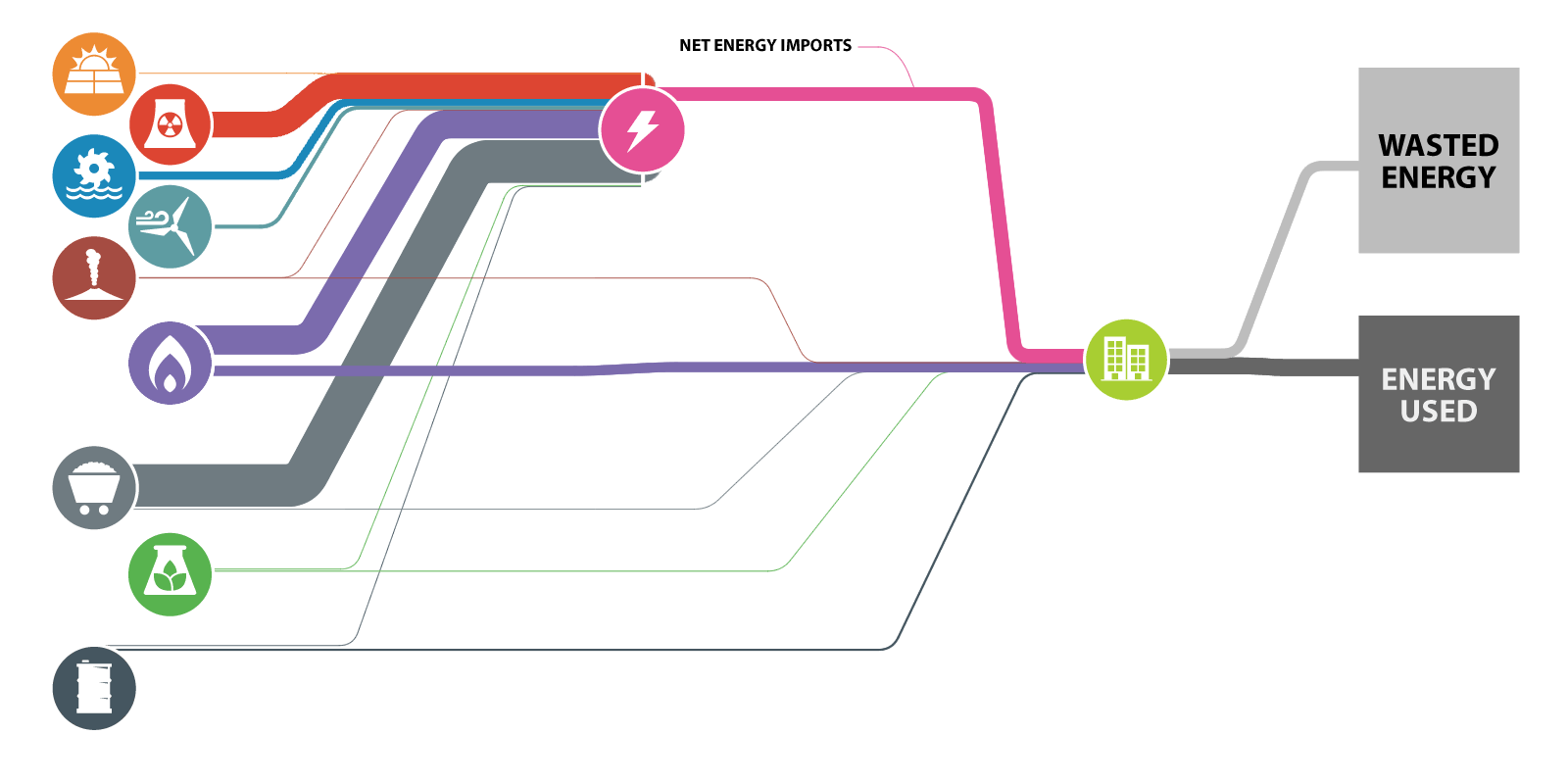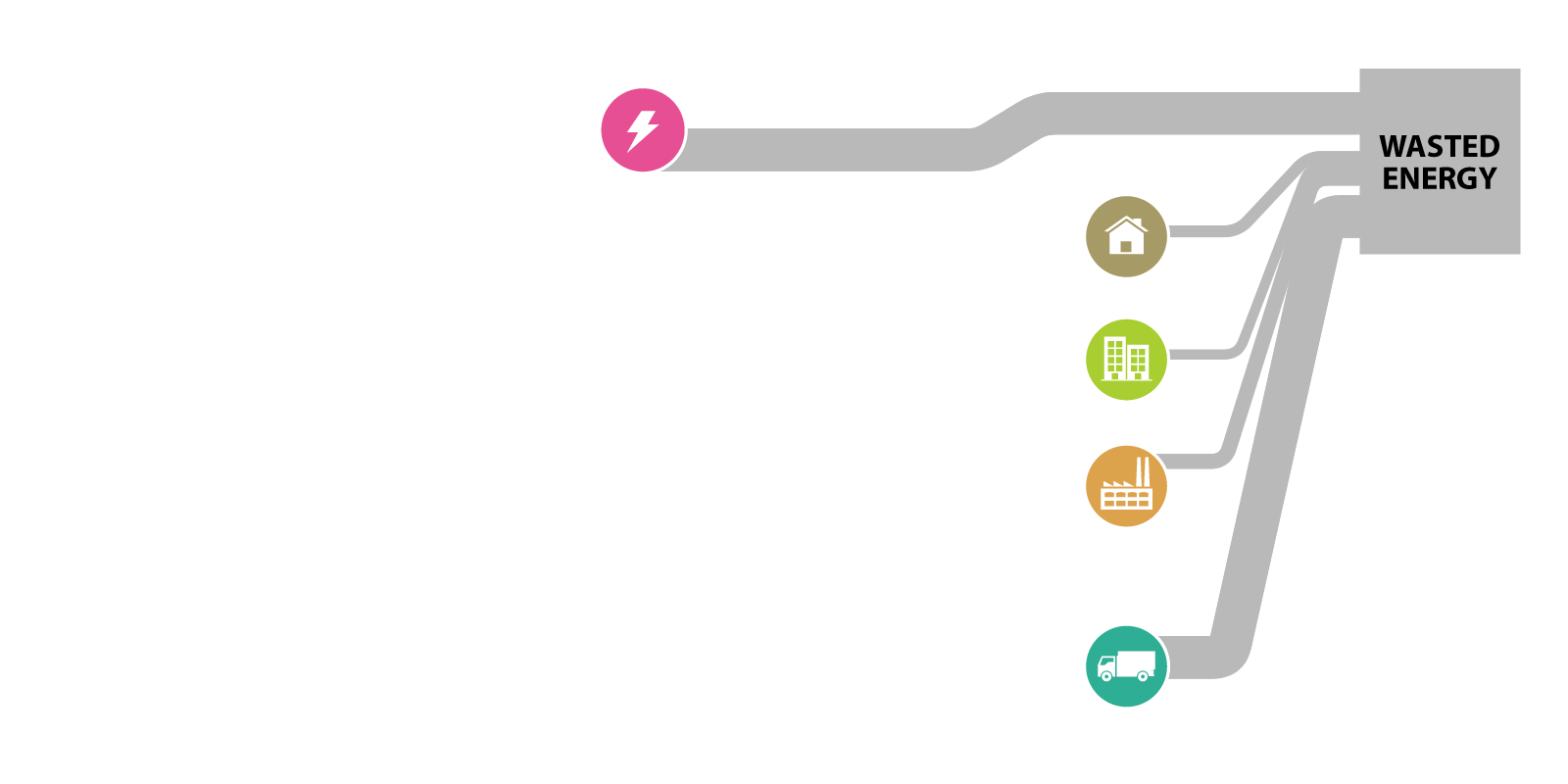

















Estimated United States Energy Use
Click on the different icons on this chart to explore all of our energy systems.
On the left are primary sources of energy. This is the stuff from which we generate electricity, produce fuel for our cars, heat for our homes, and power for our businesses. You can follow each of these energy sources through the chart to see the relative uses of that kind of energy in each sector of the economy.
Don’t miss the gray boxes on the right.
Solar
Solar makes up 0.39 percent 1 of the electricity generation of our grid. Most solar is used for residential electrical and heating needs. The rest of the economy uses a negligible amount of solar energy at this time but these sectors are expected to grow their solar draw as economic conditions improve solar return-on-investment (ROI) values.
Nuclear
There are 99 nuclear power facilities2 operating in the United States and 437 (with 66 under construction) in the world3 which supply 13 percent (2518 TwH) of global consumption4. Nuclear power plants are used almost exclusively to produce electricity. Dealing with the radioactive byproducts of nuclear power generation has proven to be a political and environmental challenge around the world.
Hydro
There are 133 hydro power dams in the U.S. producing 101,000 megawatts of power5. New dam development has slowed here in response to concerns of environmental disruption and human displacement. Consequently, river damming is not expected to grow generation capacity in the U.S. in coming years. In fact, some hydroelectric dams have recently been removed. Ocean current and wave power generation may gain traction if model projects in development now prove successful.
Wind
There are over 48,000 wind turbines in the United States producing 875 megawatts of electricity/year6. Europe leads the way with wind, having installed capacity of 128.8 GW7. Offshore wind makes up the bulk of new installations in Europe, while the U.S. has shown reluctance to move ahead with its numerous potential offshore wind projects.
Geothermal
Geologists have mapped most of the thermal gradients on earth and have identified places where geothermal energy could be economically used. Like other forms of energy, geothermal will only gain traction when it becomes financially competitive with existing forms of energy generation. The U.S. is currently using the equivalent of 17,000 gigawatts of geothermal energy8 while the total estimated commercially viable capacity is 100,000 gigawatt (100 terrawatt) by the year 20509. Residential geothermal is essentially unlimited, assuming landowners bear the cost of installation.
Coal
Coal is used almost exclusively for electricity generation, with a small part being used in industrial applications. It is a comparatively inexpensive fuel because it is dug up, cleaned up, delivered, and burned. It doesn’t require a lot of refinement or extensive infrastructural improvements to use. The downside of coal, however, is that it is a carbon-intensive fuel that invariably produces greenhouse gases in quantities that have proven to be scientifically alarming and politically controversial.
Gas
Natural gas is used in all sectors of the economy, with the bulk of it going to manufacturing and electrical generation. There is substantial infrastructure in place to provide natural gas to homes and businesses to meet heating needs. The transportation sector continues to add natural gas-powered vehicles to the American fleet.
BioFuel
Biofuel is fuel made from recently living organisms, either derived or burned directly (in which case it is usually called biomass) and includes things like wood, cellulose, manure, food crops, agricultural waste, compost, and animal carcasses. Approximately 10% of global energy use consists of biofuels. Secondary biofuels include ethanol and biodiesel. Ethanol is a corn- or other grain-derived alcohol often added to gasoline. Biodiesel is a plant-based alternative to petroleum diesel and can be used as home heating oil as well.
Oil
Petroleum is primarily used to create fuels for transportation, with a sliver being used for electricity generation. In the residential sector, many homes in the U.S., especially in the Northeast, use home heating oil derived from petroleum to heat their homes.
Residential
All but a few residential customers use commercially-produced and grid-delivered electricity for their electrical needs and many still use natural gas and petroleum products for heating. Geothermal and solar are making inroads in the residential sector as costs become competitive.
Commercial
The commercial sector shows electricity as its largest power contributor, while gas and geothermal contribute to heating. Gas and biofuels team up to fulfill commercial cooking needs. Anyone hungry for wood-fired pizza?
Industrial
The industrial sector draws the most power of all the economic sectors, using gas and oil to heat furnaces, boilers, kilns, foundries, and more. Interestingly this sector uses comparatively little electricity. Industry is estimated to have a higher efficiency in their energy usage than other sectors as well, as can be seen on the right side of the icon.
Transportation
The transportation sector is largely running on petroleum products at this time. Gasoline and diesel dominate in ground-based vehicles, and very few planes run on anything but petroleum fuels. Worth noting are the terrible efficiency levels of this sector, where waste vastly outweighs productive usage.
Energy Used
This box represents energy successfully used to do the things it was intended to do. It heated things that needed to be heated, moved things that needed to be moved and provided light where light was desired. The primary sources of energy and the methods of generation vary widely from country to country and even person to person. How much do you think this chart will change in the coming years? Will any new sources be added on the left? Will end-user generation increase? Will per capita use increase or decrease? Who benefits from the answers to each of these questions?
Wasted Energy
This box and the paths leading to it portray energy that was produced and consumed but was not used for the purposes for which it was intended. In most cases, this means heat was produced instead of something else, like electricity or motion. Electrical generation plants powered by coal, gas, oil, and nuclear reactions all need cooling towers and large amounts of water because they produce so much excess heat. Internal-combustion-engine-powered cars need radiators and coolant because their engines get so hot. Capturing that excess heat and reusing it is not yet economically viable, so it is usually vented to the atmosphere.
Note that there is waste in every sector; in some cases far more than that which is used for its intended purposes.
Close analysis reveals that more than half of all the energy we create is wasted. The transportation sector wastes the largest percentage of energy and a great deal of generated electricity is also lost to waste heat, over-production, and system inefficiencies.
For the person or company who shrinks or eliminates this box, there are fortunes to be made.
Electrical Generation
Coal, Natural Gas, and Nuclear form the core of our electrical generating capacity, though we get some electricity from all primary sources. Electricity is used in buildings both residential and commercial for most non-natural lighting and some heating, and many manufacturing devices are powered by electricity in the industrial sector. The electric vehicle segment is rapidly growing after failing to capture interest for several decades.